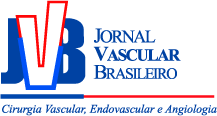Prevalência de insuficiência venosa superficial dos membros inferiores em pacientes obesos e não obesos
Prevalence of lower limbs superficial venous insufficiency in obese and non-obese patients
Amélia Cristina Seidel; Amanda Sampaio Mangolim; Leandro Pablos Rossetti; Juliana Regina Gomes; Fausto Miranda Jr
Resumo
Palavras-chave
Abstract
Keywords
References
Abu-Own A, Scurr JH, Coleridge Smith PD. Saphenous vein reflux without incompetence at the saphenousfemoral junction. Br J Surg.. 1994;81:1452-4.
Pappas PJ, Lal BK, Cerveira JJ, Padberg FT Jr, Duran WN. Causes of severe chronic venous insufficiency. Semin Vasc Surg.. 2005;18:30-5.
Labropoulos N, Leon LR Jr. Duplex evaluation of venous insufficiency. Semin Vasc Surg.. 2005;18:5-9.
Melissas J, Christodoulakis M, Spyridakis M. Disorders associated with clinically severe obesity: significant improvement after surgical weight reduction. South Med J.. 1998;91:1143-8.
Buchwald H. Overview of bariatric surgery. J Am Coll Surg.. 2002;194:367-75.
Bergan JJ, Pascarella L. Severe Chronic venous insufficiency: primary treatment with sclerofoam. Semin Vasc Surg.. 2005;18:49-56.
Callam MJ. Epidemiology of varicose veins. Br J Surg.. 1994;81:167-73.
Ageno W, Piantanida E, Dentali F. Body mass index is associated with the development of the post-thrombotic syndrome. Thromb Haemost.. 2003;89:305-9.
Jawien A. The influence of environmental factors in chronic venous insufficiency. Angiology.. 2003;54:S19-31.
Douketis JD, Paradis G, Keller H, Martineau C. Canadian guidelines for body weight classification in adults: application in clinical practice to screen for overweight and obesity and to assess disease risk. CMAJ.. 2005;172:995-8.
Iannuzzi A, Panico S, Ciardullo A. Varicose veins of the lower limbs and venous capacitance in postmenopausal women: relationship with obesity. J Vasc Surg.. 2002;36:965-8.
Beebe-Dimmer JL, Pfeifer JR, Engle JS, Schottenfeld D. The epidemiology of chronic venous insufficiency and varicose veins. Ann Epidemiol.. 2005;15:175-84.
Fowkes FGR, Lee AJ, Evans CJ, Allan PL, Bradbury AW, Ruckley CV. Lifestyle risk factors for lower limb venous reflux in the general population: Edinburgh Vein Study. Int J Epidemiol.. 2001;30:846-52.
Lionis C, Erevnidou K, Argyriadou S, Vlachonikolis I, Katsamouris A, Antonakis N. Chronic venous insufficiency. A common health problem in general practice in Grecce. Int Angiol.. 2002;21:86-92.
Ruckley CV, Evans CJ, Allan PL, Lee AJ, Fowkes FGR. Chronic venous insufficiency: clinical and duplex correlations. The Edinburgh Vein Study of venous disorders in the general population. J Vasc Surg.. 2002;36:520-5.
Raju N, Neglén P. Chronic Venous Insufficiency and Varicose Veins. N Engl J Med.. 2009;360:2319-27.
Safar H, Shawa N, Al-Ali J, Al-Nassar M, Dashti H, Asfar S. Is there a need for Doppler vascular examination for the diagnosis of varicose vein? A prospective study. Med Princ Pract.. 2004;13:43-6.
van Bemmelen PS, Bedford G, Beach K, Strandness DE. Quantitative segmental evaluation of venous valvular reflux with duplex ultrasound scanning. J Vasc Surg.. 1989;10:425-31.
Fowkes FGR, Evans CJ, Lee AJ. Prevalence and risk factors of chronic venous insufficiency. Angiology.. 2001;52:S5-S15.
Kurz X, Kahn SR, Abenhaim L. Chronic venous disorders of the leg: epidemiology, outcomes, diagnosis and management. Summary of an evidence-based report of the VEINES task force. Venous Insufficiency Epidemiologic and Economic Studies. Int Angiol.. 1999;18:83-102.
Sugerman HJ, Sugerman EL, Wolfe L. Risks and benefits of gastric bypass in morbidly obese patients with severe venous stasis disease. Ann Surg.. 2001;234:41-6.
Padberg F Jr, Cerveira JJ, Lal BK, Pappas PJ, Varma S, Hobson RW. 2nd. Does severe venous insufficiency have a different etiology in the morbidly obese? Is it venous?. J Vasc Surg.. 2003;37:79-85.
Porter JM, Moneta GL. Reporting standards in venous disease: an update. International Consensus Committee on Chronic Venous Disease. J Vasc Surg.. 1995;21:635-45.
van Rij AM, De Alwis CS, Jiang P. Obesity and impaired venous function. Eur J Vasc Endovasc Surg.. 2008;35:739-44.
Danielsson G, Eklof B, Grandinetti A, Kistner RL. The influence of obesity on chronic venous disease. Vasc Endovascular Surg.. 2002;36:271-6.
Scott TE, LaMorte WW, Gorin DR, Menzoian JO. Risk factor for chronic venous insufficiency: a dual case-control study. J Vasc Surg.. 1995;22:622-8.
Brand FN, Dannenberg AL, Abbott RD, Kannell WB. The epidemiology of varicose veins: the Framingham study. Am J Prev Med.. 1988;4:96-101.
Evans CJ, Fowkes FGR, Ruckley CV, Lee AJ. Prevalence of varicose vein and chronic venous insufficiency in men and women in the general population: Edinburg Vein Study. J Epidemiol Community Health.. 1999;53:149-53.
Mekky S, Schilling RSF, Walford J. Varicose veins in women cotton workers. An epidemiological study in England and Egypt. Br Med J.. 1969;2:591-5.
Sisto T, Reunanen A, Laurikka J. Prevalence and risk factors of varicose veins in lower extremities: mini-Finland health survey. Eur J Surg.. 1995;161:405-14.
Seidell JC, de Groot L, van Sonsbeek JL, Deurenberg P, Hautvast J. Associations of moderate and severe overweight with self-reported illness and medical care in Dutch adults. Am J Public Health.. 1986;76:264-9.
Seidell JC, Bakx KC, Deurenberg P, van den Hoogen H, Hautvast J, Stijnen T. Overweight and chronic illness--a retrospective cohort study, with a follow-up of 6-17 years, in men and women of initially 20-50 years of age. J Chronic Dis.. 1986;39:585-93.
van Noord PA, Seidell JC, den Tonkelaar I, Baanders-van Halewijn EA, Ouwehand IJ. The relationship between fat distribuition and some chronic disease in 11,825 women participating in the DOM-project. Int J Epidemiol.. 1990;19:564-70.
Stanhope JM. Varicose veins in a population of lowland New Guinea. Int J Epidemiol.. 1975;4:221-5.
Malhotra SL. An epidemiological study of varicose veins in Indian railroad workers from the South and North of India, with special reference to the causation and prevention of varicose veins. Int J Epidemiol.. 1972;1:177-83.
Robertson L, Evans C, Fowkes FG. Epidemiology of chronic venous disease. Phlebology.. 2008;23:103-11.
Kostas TI, Ioannou CV, Drygiannakis I. Chronic venous disease progression and modification of predisposing factors. J Vasc Surg.. 2010;51:900-7.
Lemaire R. The flow of venous blood in the obese. Phebologie.. 1988;41:493-9.
Pitta GBB. Cirurgia de varizes na obesidade. Angiologia e cirurgia vascular: guia ilustrado. 2003.

